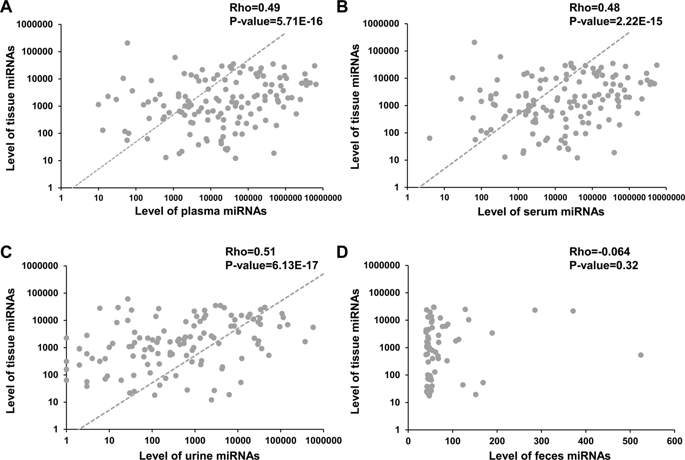Scientific Reports ( IF 3.8 ) Pub Date : 2020-03-27 , DOI: 10.1038/s41598-020-62534-6 Chunmei Cui 1 , Qinghua Cui 1, 2

|
It is known that many microRNAs (miRNAs) stably exist in various body fluids, however, the relationship of body fluids miRNAs (BF-miRNAs) with those from tissues (T-miRNAs) remains largely unclear but is important for understanding the potential of BF-miRNAs to be biomarkers of specific diseases. Here by analyzing miRNA expression data from 40 human healthy tissues and those from human body fluids, including plasma, serum, urine, bile, and feces, we revealed a positive correlation between BF-miRNAs and T-miRNAs. Moreover, plasma and serum have the most communication with pericardium, adipose, liver, and spleen. Urinary miRNAs show the highest correlation with kidney miRNAs. For fecal miRNAs, gastrointestinal tract (colon, ileum, jejunum, small intestine, stomach, proximal colon, duodenum, and distal colon) miRNAs show the strongest correlation. Moreover, miRNA set enrichment analysis revealed that highly expressed fecal miRNAs are mostly associated with gastric and colon cancers etc. Additionally, bile miRNAs from suspected cholangiocarcinoma patients show a positive correlation with the cholangiocarcinoma tumor tissue. Interestingly, the relationship of BF-miRNAs and T-miRNAs shows significant sex differences. Serum miRNAs showed higher correlation with T-miRNAs in males, whereas plasma miRNAs and urine miRNAs showed higher correlations with T-miRNAs in females. These findings together indicate a potential role of BF-miRNAs as biomarkers to monitor corresponding specific human diseases.
中文翻译:

人体组织microRNA与体液中microRNA的关系。
已知许多microRNA(miRNA)稳定地存在于各种体液中,但是,体液中的miRNA(BF-miRNA)与来自组织的体液(T-miRNA)之间的关系仍然不清楚,但对于了解BF的潜力很重要-miRNA是特定疾病的生物标记。在这里,通过分析来自40个人体健康组织和人体液体(包括血浆,血清,尿液,胆汁和粪便)的miRNA表达数据,我们揭示了BF-miRNA和T-miRNA之间存在正相关。此外,血浆和血清与心包,脂肪,肝脏和脾脏之间的联系最多。尿液miRNA与肾脏miRNA的相关性最高。对于粪便miRNA,胃肠道(结肠,回肠,空肠,小肠,胃,近端结肠,十二指肠和远端结肠)miRNA显示出最强的相关性。此外,miRNA集富集分析显示,高表达的粪便miRNA主要与胃癌和结肠癌等有关。此外,疑似胆管癌患者的胆汁miRNA与胆管癌的肿瘤组织呈正相关。有趣的是,BF-miRNA和T-miRNA的关系显示出明显的性别差异。男性的血清miRNA与T-miRNA具有更高的相关性,而女性的血浆miRNA和尿液miRNA与T-miRNA具有更高的相关性。这些发现共同表明了BF-miRNA作为生物标记物以监视相应的特定人类疾病的潜在作用。疑似胆管癌患者的胆汁miRNA与胆管癌肿瘤组织呈正相关。有趣的是,BF-miRNA和T-miRNA的关系显示出明显的性别差异。男性的血清miRNA与T-miRNA相关性更高,而女性的血浆miRNA和尿液miRNA与T-miRNA相关性更高。这些发现共同表明了BF-miRNA作为生物标记物以监视相应的特定人类疾病的潜在作用。疑似胆管癌患者的胆汁miRNA与胆管癌肿瘤组织呈正相关。有趣的是,BF-miRNA和T-miRNA的关系显示出明显的性别差异。男性的血清miRNA与T-miRNA具有更高的相关性,而女性的血浆miRNA和尿液miRNA与T-miRNA具有更高的相关性。这些发现共同表明了BF-miRNA作为生物标记物以监视相应的特定人类疾病的潜在作用。











































 京公网安备 11010802027423号
京公网安备 11010802027423号